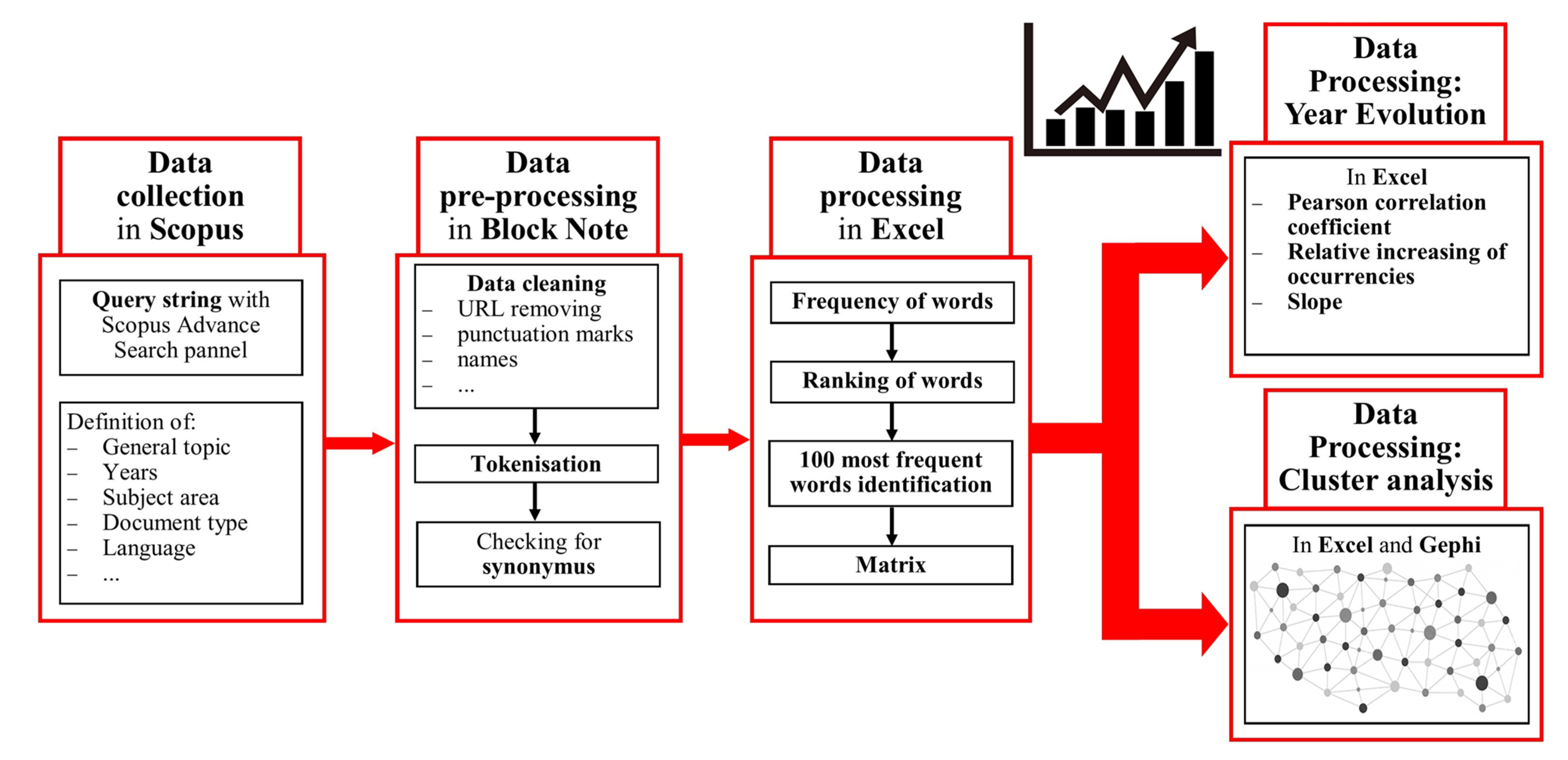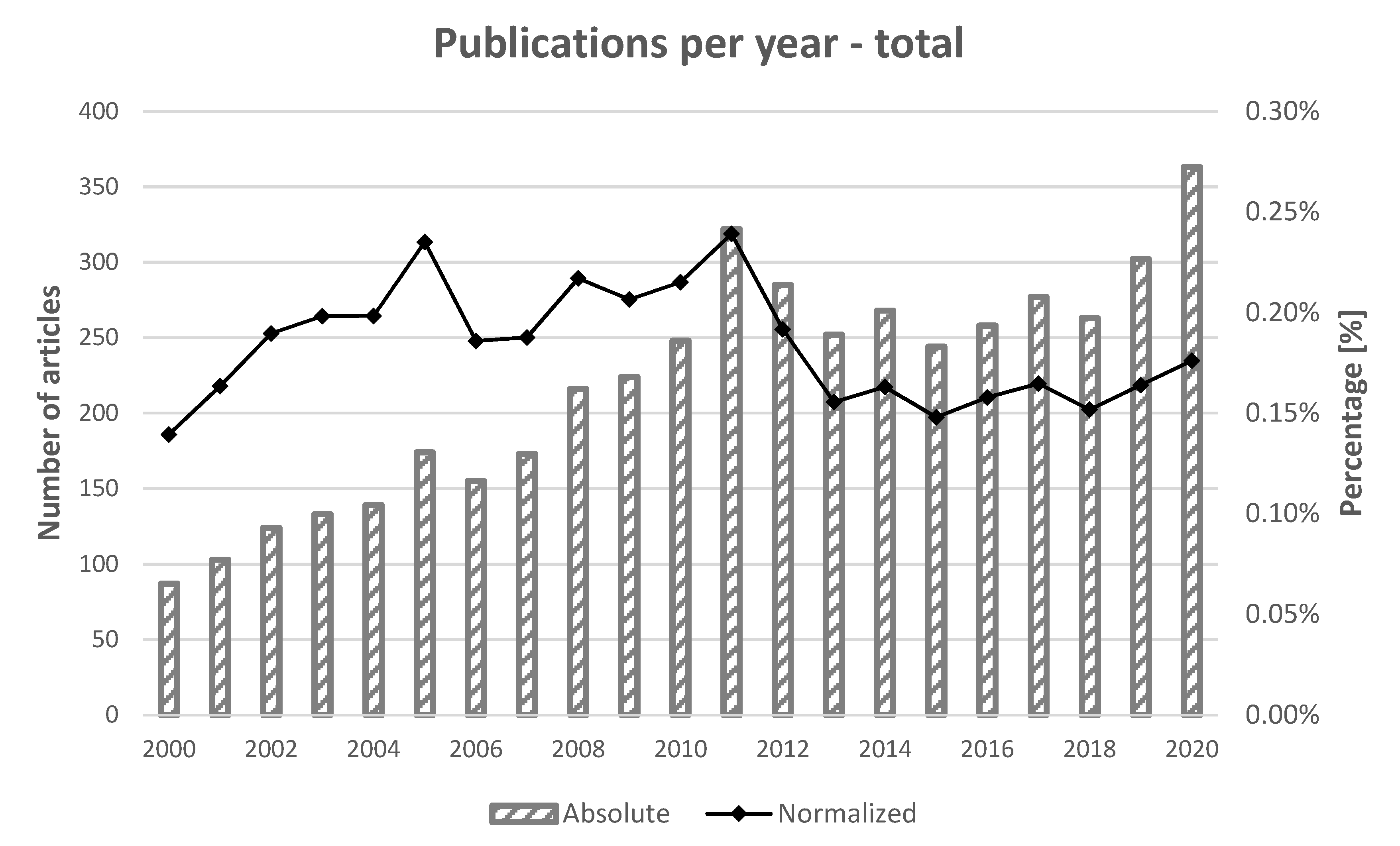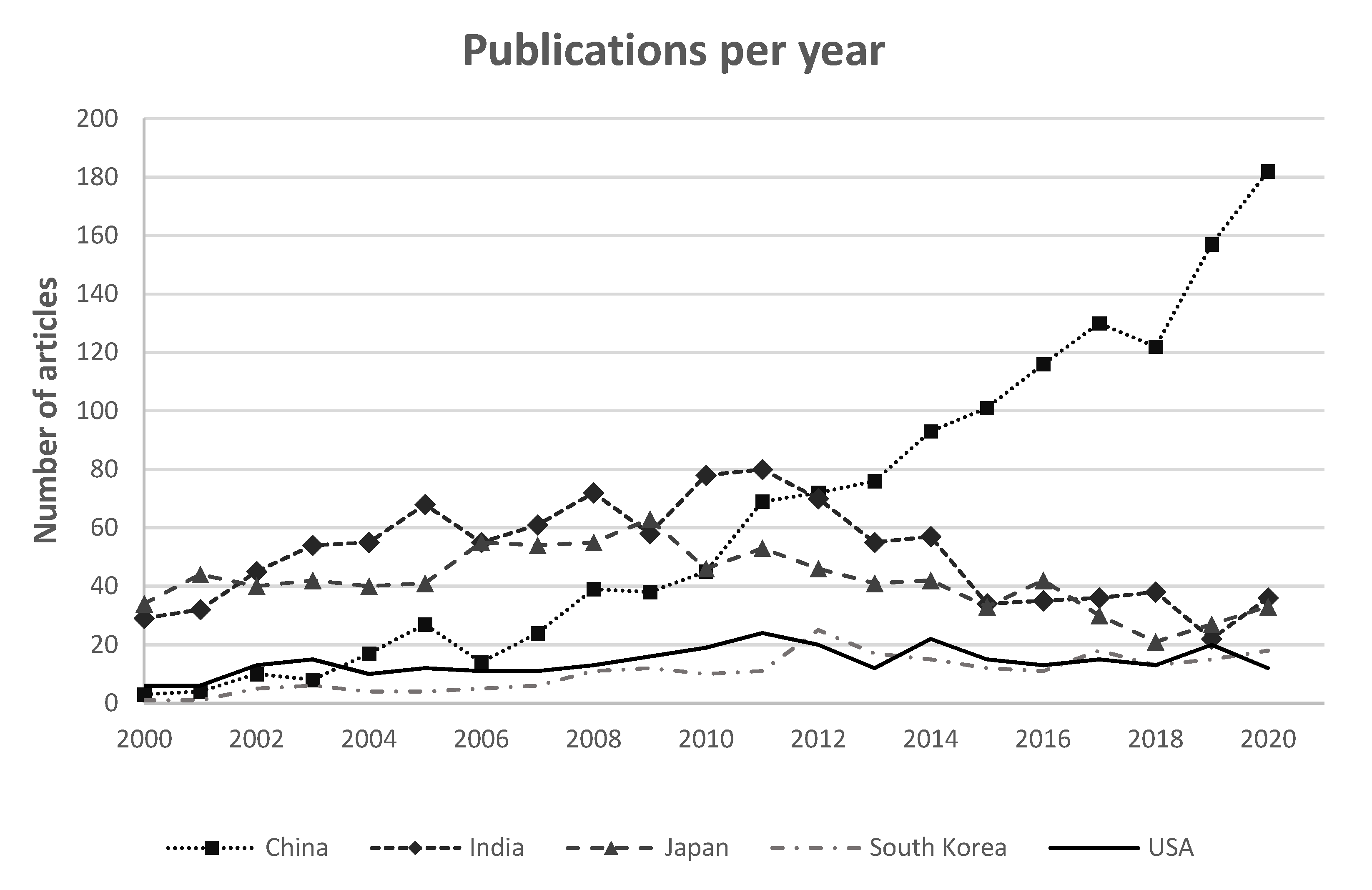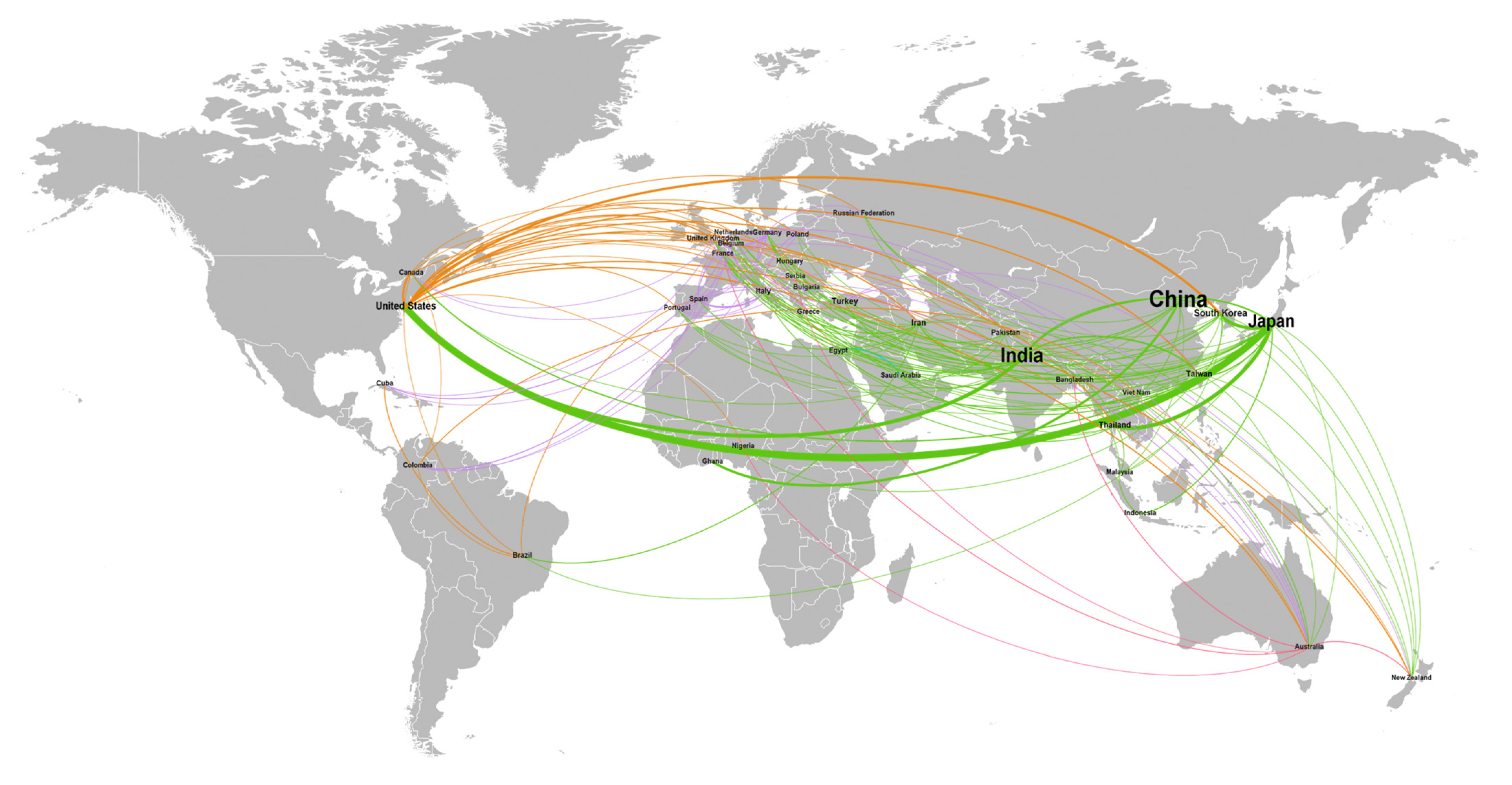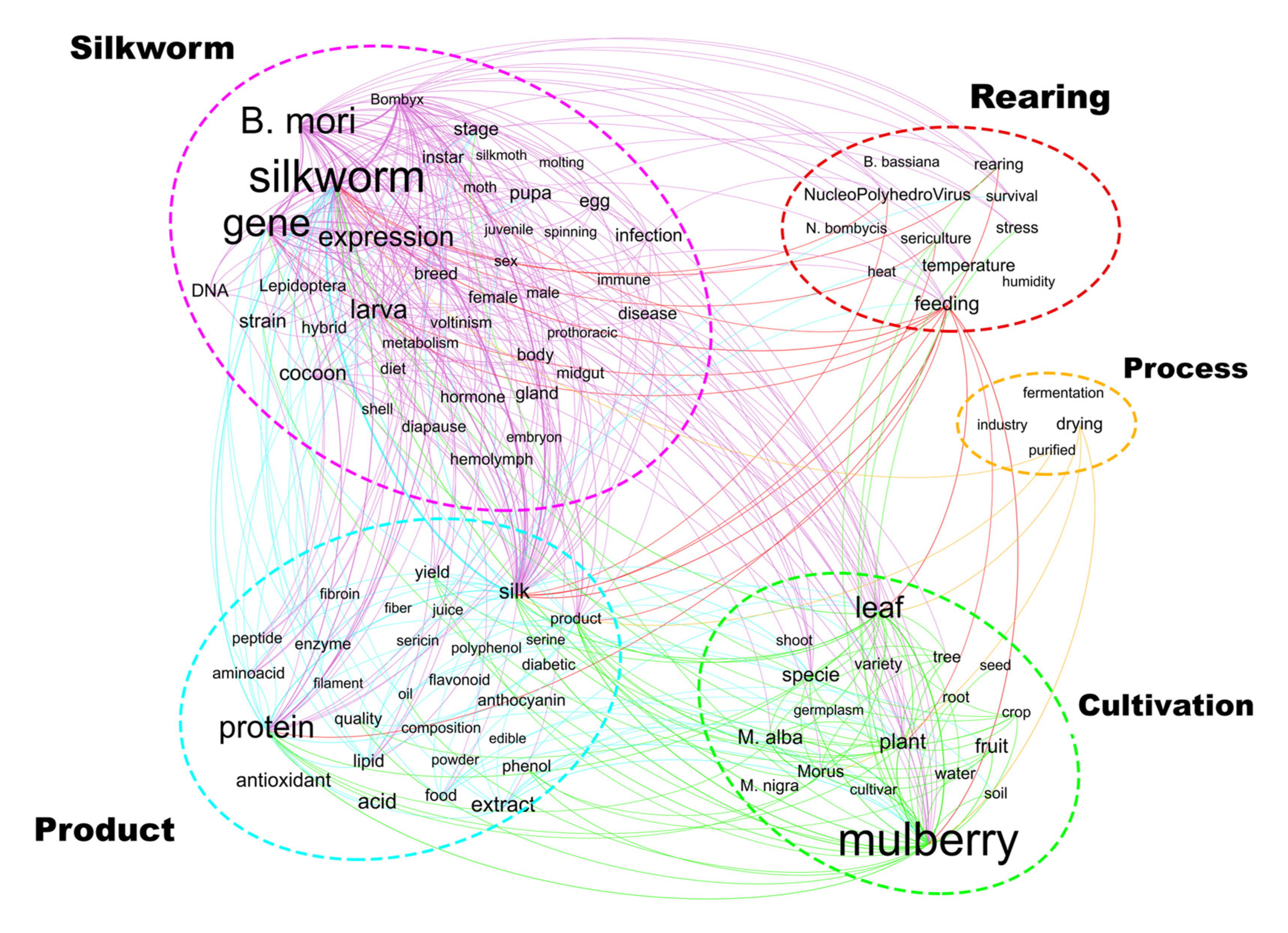1. Introduction
Sericulture is the agricultural activity that traditionally consists in the cultivation of mulberry trees (
Morus sp.pl.) to yield leaves that are used for feeding silkworms (
Bombyx mori L.), reared for silk production. In an ancient period of Human history, the trade of silk represented an important activity that allowed a first kind of globalization, connecting, since about 2000 years ago, Europe to Asia through the so-called “Silk Road” [
1,
2,
3,
4]. Nowadays, silk production represents about the 0.2% in value of total world textile production and it is spread over about 60 countries [
5]. The most important countries for silk production are China, India, Uzbekistan, Vietnam, Thailand, and Brazil [
5].
The term “silk” refers to a class of natural structural proteins produced and spun as long fibrous filament by different Arthropoda, for example Lepidoptera and spiders [
6,
7,
8,
9]. The most famous and studied type of silk is produced by the domestic silkworm
B. mori L. [
6].
From the beginning of silk manufacturing, silk has been used essentially for textile and medical applications, since efforts in medical research demonstrated how silk could be successfully applied to surgery due to its biocompatibility [
10,
11,
12]. Over the last few years, there has been a growing interest in the engineering of biomaterials capable of mimicking the structure and characteristics of tissues and several studies have focused on the use of natural silk fibroin [
10,
13,
14,
15], due to its high biocompatibility when separated from sericin [
13]. In recent years even sericin acquired a high commercial value [
16] thanks to a series of properties that make it suitable for application in the pharmaceutical, cosmetic and food sector [
17]. In fact, sericin has been shown to have several biological activities, such as antioxidant and anti-tyrosinase properties [
17,
18,
19,
20] and it is used for controlled drug-releasing biomaterials to promote stability and prolonged administration of drugs, enzymes and insulin [
20,
21,
22].
To produce commercial silkworm eggs male and female larvae of pure strains are reared in a dedicated environment to create the parental lines that are then crossed among them [
23]; the most common parental lines belong to Chinese and Japanese strains [
24,
25]. Hybrids and polyhybrids are in general more productive than pure strains and more resistant to biotic and abiotic stress; Nevertheless the management of environmental parameters, as air temperature and relative humidity, is fundamental for the optimal development of reared larvae since these factors heavily affects larval metabolism [
26].
Traditionally,
B. mori larvae feed on fresh leaves of the white mulberry (
Morus alba L.) [
27,
28], although even leaves of other species belonging to
Morus genus can be used [
29]. Leaves of
M. alba contain the optimal amount of nutrients and compounds that are fundamental for the growth and development of
B. mori larvae and for their silk cocoon spinning. Besides being the only feeding source for silkworms, several studies have also been focused on alternative uses of by-products from
Morus: leaves, roots, stems, and fruits of different species belonging to the
Morus genus (in particular,
M. alba and
nigra L.), contain relatively high amounts of phenols [
30,
31,
32], in particular flavonoids [
32,
33,
34] with predominant quercetin and kaempferol glycosides as well as anthocyanins [
35]. Different experiments showed how mulberry cultivation can represent an interesting and sustainable source of these compounds for nutraceuticals, which are usually contained in the mulberry leaf powder and mulberry fruit juice [
36,
37].
The previous paragraphs offer a brief overview about the whole compart of the silk production and show how the theme is wide and linked to several other topics, as engineering, medicine, and nutrition. In this complex framework, a text-mining analysis as proposed by Cogato et al. [
38] and Ferrari et al. [
39] seems to be appropriate to appreciate the interconnection among the hotspots of the research over the past two decades, from 2000 to 2020. This kind of analysis, in fact, allows to objectively identify and weigh the most important topics in a specific research field and to study how they interact.
The aim of the present analysis is to provide a general and comprehensive review of the state-of-the-art of literature about sericulture in the fields of agriculture and biological sciences. The specific objectives of this work were to: (i) provide a description of the temporal trend of publications over the past 20 years; (ii) identify the most important topics to which the research for sericulture field has been mainly directed; and (iii) analyze the most important links among topics; this aspect is very important since sericulture is based on the interactions of different production chains and processes. In order to obtain such results authors decided to perform a quantitative analysis that is the most effective and objective methodology to achieve the above-mentioned specific goals.
2. Materials and Methods
As first step for the bibliometric analysis, the authors downloaded a collection of documents indexed by the SCOPUS database, taking advantage of the advanced search to precisely define the topics. The analysis of scientific documents contained in the SCOPUS database allowed the authors to understand how the interests of researchers developed and changed in the past years.
The authors performed a text mining process of the selected documental collection, in order to derive significant numeric indices and information, by analyzing unstructured (textual) information. The statistical analysis of these indices provides a key to the text interpretation, obtaining high-quality information useful for content interpretation. The words appearing in the title, keywords, and abstract of all articles were first pre-processed in the Microsoft® pre-installed Notepad environment and used for the creation of basic graphs in Microsoft® Excel®; the more elaborated graphical representations were obtained using Gephi (Gephi® Consortium, Compiegne, France), an open-source software developed to perform network analysis.
2.1. Article Selection
The analysis was based on the words “
silkworm” and “
mulberry” both as parts of the process that leads to silk production. Moreover, to include articles containing the derived forms of those two nouns, the scripts “silkworm * ” and “mulberry * ” were used for the initial research in SCOPUS, since the asterisk “*” indicate any word-related declination: e.g., “mulberry”, “mulberries”, “mulberroside” and so on (
Table 1). With the initial examination, the program selected the articles that contain the string “silkworm” and “mulberr” and their derived terms in the title, keywords, or abstract. The authors applied some filters (in
Table 1, Filter application n.1) for a more pertinent selection of the articles: the field was limited to “Agricultural and Biological Sciences”, the language was limited to “English” and the type of document was limited to “Scientific Article”; the time span considered was 2000–2020. According to Author’s expectations, this analysis resulted in finding many articles (more than five thousand) even with the application of the described filters.
The authors then applied a second series of filters to reduce misleading results. In particular, the word “
Antheraea” was excluded from the research since it is linked to the topic of silk production but referred to a wild Lepidopteran rather than to
B. mori. Articles collected by popular and dissemination journals were also excluded by the research. The new script is shown in
Table 1 at Filter application n.2 row. With the applications of those new filters, the number of articles dropped to about 4600.
The download procedure from the SCOPUS database was repeated for each year between 2000 and 2020; the .csv format was chosen for the downloads.
2.2. Article Elaboration
The results of the research were converted and saved as .txt files to have all the data stored in a file format that could be easily processed. The first step of the data pre-processing was the so-called tokenization, a procedure through which the sentences are divided into their essential components (i.e., single words). All the other parts of the text as punctuation marks, hyphens, brackets, and others special characters were removed. The authors run a further elaboration to convert all capital letters into lowercase and to identify and convert singular/plural nouns (e.g., mulberry/mulberries or leaves/leaf) and synonyms (e.g., white mulberry and M. alba).
All .txt files obtained at the end of the previously described process were imported into Microsoft
® Excel
® (Microsoft 365 MSO Version 2111 Build 16.0.14701.20254 64-bit software, Microsoft Corporation, Redmond, WA, USA) to order all the single selected words and to count how many times each one appeared. This elaboration was necessary for the identification of the more frequent words in each considered year of the past two decades. Using Excel, the 100 most relevant words were identified and used for the subsequent analysis. Another interesting function provided by the Excel
® software is the so-called
sparkline graphs that creates a small graph into a single cell; the authors used this function to create time series graphs for all the analyzed nouns, thus recognizing in a fast way which words increased in importance during the analyzed time. As final step, the results were imported as .csv dedicated files in the Gephi software [
40], which is a free open-source software that allows for the creation of complex graphical representation of word associations. To create a connection graph in Gephi, the user has to import into the software a .csv file containing information about the
nodes (here, the most frequent nouns derived from the previous elaboration) and another .csv file containing information about the
edges, the connection thanks to which each node is related to the others. Gephi considers the edges as vectors, directed or undirected, each one with its specific
weight, which is generated as described in
Section 2.2.1.
2.2.1. Combination Matrix
A word–word connection matrix was built as detailed by Ferrari et al. [
39], based on the list of the 100 most recurrent words. The matrix had 100
2 cells and, that was the result of a total of 10,000 couples. Starting from this matrix, the authors built a dedicated connection matrix in which, for each couple of words (e.g.,
mulberry-silkworm) the number of articles that contained both the nouns was indicated; the connections of words are not directional, namely the order of the words forming the couple was not considered (e.g.,
mulberry-silkworm is equivalent to
silkworm-mulberry) in order to avoid duplications. As a result of the matrix, 4950 couples of nouns were obtained.
2.2.2. Cluster Definition
Besides the analysis for the combination matrix and therefore for studying how the nouns are interconnected, the authors performed a so-called
cluster analysis. The aim of the cluster analysis was to define a rule (or a feature, or a set of features) that allows to create groups containing a set of objects (the words in this case) and sharing one or more previously defined features: in this precise kind of cluster analysis the aim is grouping words according to the thematic area they belong to. When the main topic can be subdivided in several interrelated parts, as the one here-considered, cluster analysis allows to study and characterize the relationship among the different sections of the main topic: for example, how the cultivation of mulberry trees connects to silkworm rearing and to silkworm applications. As this analysis is only qualitative, by further differentiating results for the years or for the geographical area, it is possible to describe in a precise way the evolution of the relationship among clusters. It is worth noting that there are no fixed rules to define clusters, but the experience of the authors and the definition of precise rules, useful to minimize equivocations, allow the authors to discriminate the clusters. In the present work, the authors propose the different activities of the sericultural chain as criteria to define the clusters and, in this way, five clusters were identified: Cultivation, Silkworm, Rearing, Process and Product. All the words regarding the mulberry cultivation group in the cluster “cultivation”: for example, words pertaining to the agronomic techniques and to the plant biology. The cluster “silkworm” collects all the words referring to the biology of silkworms (e.g., strains or different stages of their life). In the cluster named “rearing” the authors pooled all the words regarding the activity of silkworm rearing, including diseases or environmental factors (e.g., air temperature) that are fundamental for the insect development. The cluster “process” includes all terms that are linked to the industrial processing of products deriving from both silkworm rearing and mulberry cultivation. The cluster “product” groups all the words that describe the production obtainable by both mulberry (e.g., important metabolites) and silkworm. Although these clusters and rules were defined to avoid ambiguities and overlapping, the authors used the combination matrix and the specific research of documents on SCOPUS to define which words best fit to different cluster.
Table 2 shows the cluster composition.
The authors classified the most frequent words by assigning to them a score calculated as weighed average of the word in the considered years. The authors calculated, per word and per year, the ratio of the number of occurrences to the total number of publications in the sericultural field; in this way the authors could objectively characterize the relative importance of the selected word in a certain year and study its trend over the considered interval of time. The authors assigned the highest weight to the most recent years to pay more attention to the last trend of research in sericulture. The score for each word was calculated as proposed by Ferrari [
41] (see Equation (1)).
In Equation (1), wi is the weight of the i-th year (from 2000 to 2020), oi is the absolute number of occurrences in the ith year and Si is the total number of publications in the ith year.
The authors analyzed the impact of the five most frequent terms of each cluster, according to Equation (1). To this end, the impact of the papers related to such terms was quantified in terms of Hirsch’s h-index. Thus, for a given term, the h-index has been calculated here by counting the number h of publications including that term and cited at least that same number h of times. The average was then computed for the five terms of each cluster.
The conceptual flux of the analysis is represented in
Figure 1.
4. Discussion
The main core of this research is represented by a text-mining analysis focused on the words in the title, abstract, and keywords of articles related to silk production. Different considerations can be drawn by the analysis of the most frequent nouns, which were previously identified and evaluated. Taking advantage of a procedure algorithm already tested by Cogato et al. and Ferrari et al. [
38,
39], the most significant relationships among nouns were recognized. Additionally, by including time parametrization, it was also possible to characterize the evolution of the research interests in sericulture. Thanks to the large number of documents considered in this study, a statistically robust analysis of research was achieved, supporting hypotheses on influences and trends in sericulture
From the characterization of the number of released publications in sericulture (see
Figure 2), it is worth noting that the absolute number of articles published per year has been increasing since 2000; such trend reflects the great interest in the topic and the interdisciplinarity of the matter. By considering this trend, two main periods can be identified: from 2000 to 2011 the trend was constantly increasing, both in absolute number and in relative percentage (considering the total number of publications indexed by the SCOPUS database), reaching a peak in 2011; the second period began in 2012 and exhibited a decrease followed by an increase until 2017. Currently, the interest is still apparently growing in absolute terms. In relative terms, the interest appears quite stable; this is due to a rather great relative increase in the total number of publications per year (from about 62 k in 2000 to more than 200 k in 2020, documents indexed by the SCOPUS database). The next decades should be monitored to determine whether these new trends are stable, or they are not. From a geopolitical and temporal point of view, such a trend should be explained by two main reasons: the decreasing number of publications per year from India, and the increasing number of publications per year from China, which is now the leading country for the research in the sericultural field.
From the analysis of the trends of single words and clusters, interesting and more specific information have been extracted. From an aggregate point of view, considering the clusters, the main arguments of investigation of the research in the past twenty years were the study of the Morus cultivation, industrial processes, and products that could derive from sericulture, from both Morus cultivation and B. mori rearing.
From the analysis of the impact of the most important words of each cluster, it is interesting to note how those words are able to generate a considerable impact in the frame of sericulture, with an overall average impact factor of about 67.
The cluster “silkworm”, related to the silkworm biology, is the largest one in terms of number of included words (according to the data of
Table 6, 46.4%) but during the last decade, and in particular in the last five years, the interest of the scientific research decreased relatively to this sericultural main topic (
Table 8). In particular, the most important words of the cluster are “silkworm” (15.3%) and “
B. mori” (10.7%), also characterized by considerable high values of the impact factor (respectively 78 and 77); this is easily understandable since the work on the living organism is the main focus of the research on this topic. The silkworm has always been an important laboratory tool for genetics and physiology of insects; in particular the independent genome sequencing of 2004 by a Chinese [
42] and a Japanese team [
43] and the integrated silkworm database of the end of 2009 [
44], gave probably place to the peak of publication on sericulture recorded in 2011. However, from 2012 (the year of FAO experts’ consultation in Rome about entomophagy “Insects to feed the world”) new insects started to be studied in relationship with the new trend of edible insects as perspective feed and food for the future; for example,
Tenebrio molitor genome was sequenced in 2020 [
45]. Exploitation of edible insects gave rise to a new impulse to research on the physiology of new and less known insects as
T. molitor and
Hermetia illucens, probably resulting in a diminished interest for traditional insects used as laboratory tools like silkworms.
However, silkworm genetics, still accounts for about 22% of the weight of this cluster. The Nucleopolyhedrosis virus (NPV) has also been used for genetic studies, and in particular as a vector for the recombinant protein technology [
46,
47,
48]. NPV research could, therefore, be considered for its importance in determining both methods for biotechnologies and silkworm physiology studies or in establishing correct rearing techniques for disinfection, disease prevention and rearing facility planning. For this reason, NPV research and other studies on silkworm diseases like pebrine (
Nosema bombycis) or white muscardine (
Beauveria bassiana) could be regarded as horizontal literature common to the cluster “Silkworm” and “Rearing”.
Another important theme of the silkworm biology is represented by the sex identification. Indeed, in order to obtain a highly-productive polyhybrid, the best male and best female individuals of different strains are reared and bred. As stated by Raj et al. [
23], different solutions for non-destructive sex-sorting methods for silkworms have been proposed [
23,
41,
49]. In fact, an efficient sexing method has not been found yet. Three other important terms of the cluster “Silkworm”, counting about 10% of the weight of the cluster, are “larva”, “cocoon” and “shell”, the raw materials for farmers who rear the larval stage of silkworm and obtain, at the end of their fifth larval instar, fresh silk cocoons.
The cluster “cultivation”, related to mulberry cultivation, is the second most important one in terms of the relative weight of the included words (according to the data of
Table 6, about one fourth). Since mulberry is the general word for the identification of
Morus sp. pl. plants, the most interesting and reliable results are about specific species. As stated before, silkworms feed mainly on
M. alba leaves [
27,
28], and the term “
Morus alba” showed a high increases in the past twenty years. The term “
Morus nigra” recorded a lower increase, located in particular in the 2016–2020 period. The term “leaf” is the second most important word in this cluster, and this is related to the fact that mulberry leaves represent the only source of food for silkworms [
27,
28]. It is worth noting how “leaf” is a word that has not exhibited an increase, as for others considered terms (
Table 5). The explanation of this trend could be related to the fact that
Morus is currently studied much more for fruits and active ingredients for pharmaceuticals than as feed for the silkworm, for which artificial diets are an innovative and attractive matter of research.
In the “product” cluster, the most recurrent word is “protein”, which represents the most important class of nutrients in mulberry leaves, the only source of nitrogen for silkworms. Thus, silkworms use the proteins obtained through dietary ingestion in order to extract the amino acids necessary to synthesize other required proteins both for their growth and for spinning cocoons [
50]. Proteins are, therefore, also important products obtained from cocoons (fibroin and sericin) and from silkworm pupae. Recombinant proteins achieved from engineered larvae also represent a “hot spot” of sericulture [
46,
47,
48,
51]. It is worth noticing how the nouns “acid” (97), “extract” (82) and “protein” (82) are characterized by very high values of the impact factor here proposed, attesting a great interest of the scientific research about the topics related to these nouns.
The “process” cluster is the one with the lowest number of occurrences and thus with the lowest weight (1.6%). Nonetheless, an actual interest on the topic can be recognized, especially in the last five years (2016–2020), when the cluster gave evidence of the highest increment. New industrial processes are currently required for recombinant protein purification, for fibroin and sericin dissolution and reconstitution, to build 3D scaffolds, biomedical products, biocompatible implantable devices and biofilms. Furthermore, to purify mulberry organic compounds, fat and proteins from pupae, new methods and processing technologies are necessary and this explains the increase of the last years linked to the emerging fields of sericultural biotechnologies, pharmaceuticals from mulberry, and edible insects [
52,
53,
54].
In the “rearing” cluster the two most relevant themes are those related to the words “feeding” (already discussed above) and “temperature”. The word “temperature” is the one with highest weight in the cluster (13.5%) and this trend is somehow confirmed also by the high attention paid by farmers as well as by researchers to the temperature control for the sericultural practice [
26,
55,
56]; in fact, some authors proposed sensor-based systems that allow the automatic control of temperature (concurrently with other environmental parameters) [
57]. For the same reason, a clear interest is also focused on other two strictly related nouns namely “heat” (4.5%) and “humidity” (2.7%). We should also highlight that climatic changes have impacted on all the agricultural activities and sericulture was also much affected by the extreme environmental conditions recorded in the last years.
